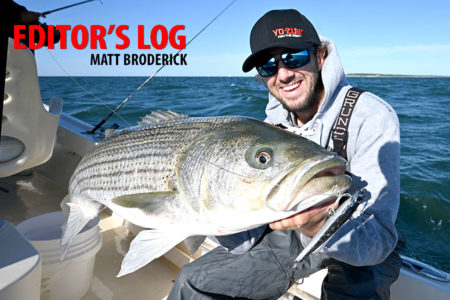On April 18, a young man from Pennsylvania fishing with his two young sons on the Jersey side of the Delaware River hooked up with the striper of a lifetime. Using bloodworm on a 7/0 circle, the shoreline caster beached a cow that broke a 50-pound scale before its release. It probably could’ve hit 60 pounds on a shop scale were it not set free.
The photo appeared on our May 2 weekly edition cover, about a week after I’d shared it on Facebook (our 21st century’s equivalent of the Salem Witch Trials). By Easter Sunday, the post had 800 likes, 240 shares and over 150 comments, four of which offered the obligatory negativity expected from today’s social media. One noticed the youngsters weren’t wearing life vests (can’t say I’ve seen many young surfcasters donning PFD’s, nor is it even a legal requirement from shore that I’m aware); another observed that the Delaware is closed to striper fishing (actually the April/May closure and circle hook requirement runs from the Salem River north to the Calhoun Street Bridge; the angler never gave his exact location, and I know enough not to ask).
And then came the Puritans, preaching the gospel of bass-handling and media exploitation. “Stop with the picks (sic),” said one, a grammatically challenged way I presume of saying folks shouldn’t share photos of big stripers. Not sure what kind of fishing magazine we’d be without publishing fish pictures! Another Debbie Downer opined “well known fishing websites and publications, ran by experts” need to do a better “PR” job of educating anglers. You know what they say about leading a horse to water? Now imagine trying to make that Clydesdale read the paper while standing at the trough!
While it may not be happening fast enough for some, I’ve personally seen a big change in angler behavior since first coming aboard The Fisherman some 17 years ago. In fact, while compiling our Easter weekend fishing reports, Phil Sciortino at the Tackle Box noted much the same by saying “it looks like catch and release is becoming very fashionable in Raritan Bay.”
That Delaware River surfcaster with the fish of a lifetime shared a few video snippets with me, one I shared with viewers of our weekly online video forecast. I chose not to run the entire clip given the background scenery could’ve easily burned his spot, a far worse fate than getting burned at the stake in Colonial Massachusetts. In that video, a young son asks his father, “is that pregnant” while holding the camera phone pointed towards dad and fish, together in water. “Yeah it’s pregnant,” dad responds, lightly holding the fish’s head and body in the Delaware as if performing an Easter baptismal. “All glory to God on this,” dad says before the video fades and the fish is set free.
Fisheries managers assume 9% of the stripers we anglers release will die; that number fluctuates depending on many variables including stress to the fish, gear used, air temps and water conditions. Monmouth University researcher John Tiedemann co-authored a rather comprehensive report on reducing mortality in the recreational striped bass fishery; Google it by searching Accessing Impacts of Catch and Release Practices in Striped Bass.
The study offers solid advice on reducing physical stress on stripers prior to release, recommending use of circle hooks, swapping out trebles on plugs, lessening fight time (i.e., using heavier tackle), cradling fish rather than hoisting vertical, keeping the fish in the water at all times while unhooking, and of course releasing as quickly as possible (see this week’s Inshore column for more).
They’re great things to keep in mind this season, especially as we continue to improve on our collective efforts to conserve the spawning stock. But like leading a horse to water and teaching it read, finding one sinless person in the temple of the striped bass to whom we present the first casting stone remains quite the challenge.





